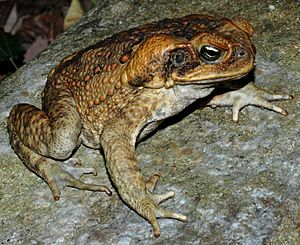Parotoid gland facts for kids

The parotoid gland is a special skin gland found on the back, neck, and shoulders of toads. Some frogs and salamanders also have them. These glands produce a substance that helps protect the animal from predators.
When a predator tries to attack, the gland releases a milky, bad-tasting substance. This substance tells the predator that the animal is toxic or poisonous. It acts as a warning, often making the predator let go of the toad or frog.
What are Parotoid Glands?
Parotoid glands are like large, raised bumps on an amphibian's skin. They are usually located behind the animal's eyes, near its ears. These glands are a normal and healthy part of the animal's body. They are not a sign of sickness or infection.
How Do They Protect Animals?
The substance released by parotoid glands is called bufotoxin. This chemical acts as a neurotoxin, which means it affects the nervous system. When a predator bites or tries to eat an animal with these glands, the bufotoxin can cause a strong, unpleasant reaction.
- It tastes very bad.
- It can make the predator feel sick.
- In some cases, it can be dangerous to the predator.
This defense mechanism helps the toad or salamander escape. It teaches predators to avoid these animals in the future.
Parotoid Glands vs. Warts
Many people believe that touching a toad can give you warts. This is a common myth, but it is not true. Warts on humans are caused by viral infections. Parotoid glands are natural parts of an amphibian's body. They are not warts and cannot spread to humans.
So, while it's always good to wash your hands after touching any animal, you don't have to worry about getting warts from a toad's parotoid glands.
See also
- In Spanish: Glándula parotoide para niños

